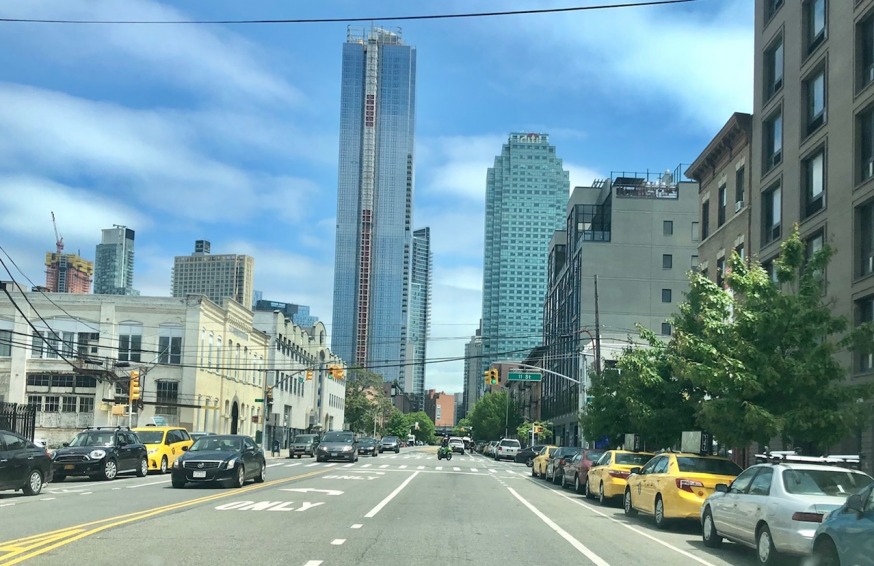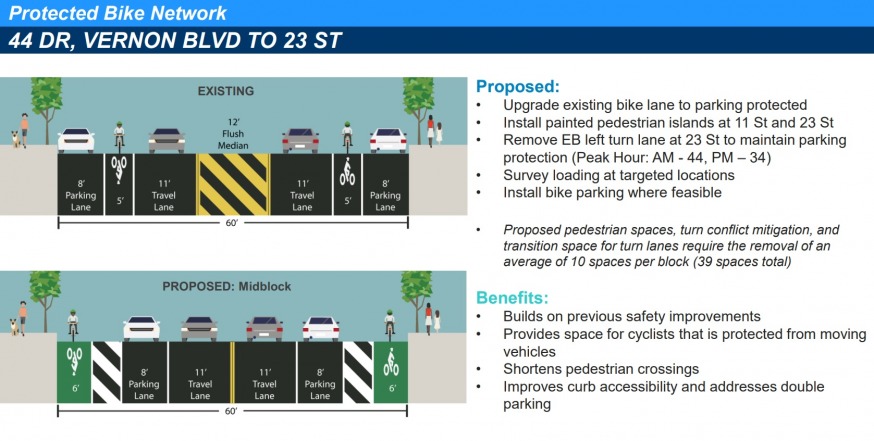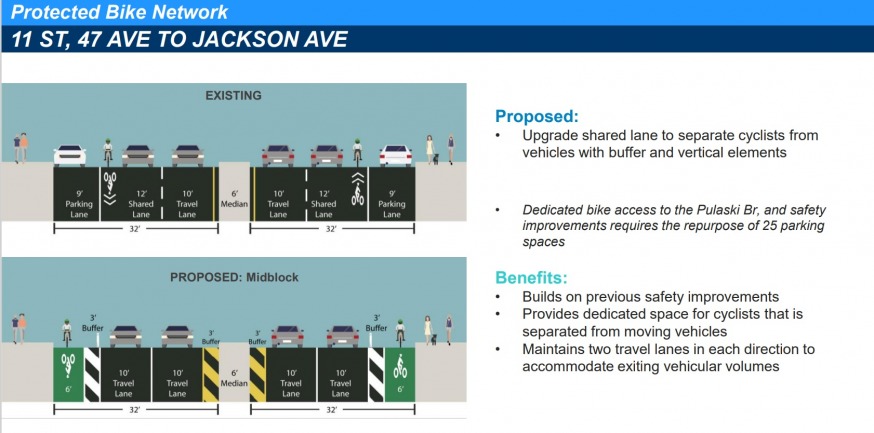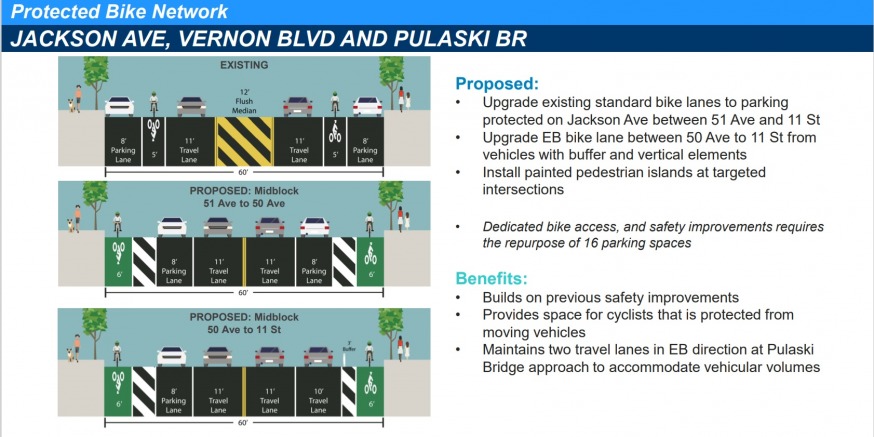
44th Drive, an east-west route that links Court Square with Hunters Point, where protected bike lanes will be installed (Photo: Queens Post)
June 21, 2022 By Christian Murray
Community Board 2 voted earlier this month in support of the Department of Transportation’s plan to install three protected bicycle lanes in Long Island City.
The vote, which was passed unanimously, has cleared the way for the DOT to install the protected bicycle lanes that will provide essential links between the Queensboro and the Pulaski bridges—as well as between Court Square and Hunters Point. The plan, however, will result in the loss of 107 parking spaces.
The DOT plans to install protected bike lanes on 44th Drive—between Vernon Boulevard and 23rd Street—an essential east-west corridor from Court Square toward the Long Island City waterfront.
The plan also involves a protected bike lane on 11th Street–between 44th Drive and Jackson Avenue—a key connection between the two major bridges, as well as a protected bike lane on Jackson Avenue, between Vernon Boulevard and the Pulaski Bridge.

The purple lines indicate where the DOT will be installing the protected bicycle lanes. The green lines are where protected bicycle lanes are already in place. The DOT is also reviewing the Borden Avenue link (represented in red) between Vernon Boulevard and Center Boulevard to see whether it should install protected bicycle lanes there too. The blue lines indicate the location of standard bike lanes, while the pink lines are shared lanes (DOT)
The DOT plans to install the protected bike lanes late summer/early fall.
“This is a critical part of the bike network, not only for Long Island City but for all of Queens, Brooklyn and Manhattan because this is where the Pulaski Bridge and the Queensboro Bridge connect,” said Nick Carey, with the DOT’s bike unit, during the board meeting.
The DOT also noted that the new protected bike lanes will be installed at a time when there has been a big uptick in bicycling. The agency said that cyclists are crossing the Queensboro bridge 6,400 times per day, with more than 2,000 trips across the Pulaski bridge.
The plan also comes in the wake of bike safety advocates and elected officials urging the DOT to complete a protected bike network in the Long Island City area.
The push for bike safety came to a head when Robert Spencer was killed in a crash in March 2019 while riding his bike at the intersection of Borden Avenue and 2nd Street in Hunters Point.
The DOT is likely to install a protected bicycle lane on Borden Avenue between Center Boulevard and Jackson Avenue– although the agency is still evaluating the concept.
The plans for the three protected bike lanes were largely well received, although the board did have some reservations.
There were concerns about the loss of parking spaces—particularly on Jackson Avenue near the Pulaski Bridge—since many local businesses have customers that need parking.
Additionally, others urged the DOT to find parking spots elsewhere, noting that some residents are sick or handicapped and are unable to use public transportation or ride a bike. Some also argued that the loss of parking spaces would be a burden for low-income residents since they would struggle to afford parking in a commercial garage.
The DOT said that the loss of parking was a concern but the benefits of the protected bicycle network outweighed the downside.
“We recognize that there is a downside,” Carey said. “But considering the safety benefits for all road users…we think it is on balance a net positive for the neighborhood.”
Meanwhile, Gretha Suarez, a planner with DOT’s Queens office, said that the bike network might also encourage some drivers to use public transportation or ride a bike.
Stephen Cooper, a board member, said that he wants the DOT to be responsive to the community once the lanes are installed. He said that when the DOT installed the 39th Avenue Bike Boulevard in Sunnyside last year it promised the community that it would review the design—in terms of whether it needed to be tweaked or not—soon after its completion. He said that this had not occurred and called on the DOT to pledge to review the Long Island City plan shortly after its implementation.
Meanwhile, Thomas Mituzas, a board member and co-chair of the board’s Transportation Committee, called on the DOT to do conduct outreach prior to installing the lanes. He said that when the 39th Avenue Bike Boulevard was installed last year most residents were completely unaware. He said that he doesn’t want a driver in Long Island City to go out one morning and then discover that the area where they typically park their car is gone.
Suarez said that the agency gets the message out about DOT projects via social media and through the help of community boards. She also said the projects are also on the DOT website. Additionally, fliers about the work are typically circulated.
But Morry Galonoy, the chair of Community Board 2, said that the board is largely a volunteer, unfunded government body that doesn’t have the ability to conduct large scale outreach. He said that it was up to the DOT to do more.
Some called on the DOT to do tabling events and similar outreach—as well as send staff out to the area to inform residents.
The board’s approval did come with conditions. The conditions require the DOT to make provision for handicapped parking spaces; add loading zones for small businesses; educate bicyclists as to the rules pertaining to bike lanes; and to come back to the board after its implementation for feedback.
Click here to see the plans.



10 Comments

Unanimous vote for a perfectly sensible set of bike lanes. Like CB1 with Crescent. The shambles of the no vote on the popular Skillman and 43rd Av lanes appears firmly in the rear view mirror by now. Very thankful for CB2’s forward looking vote on this!
-A resident of the Stone Age CB5 who is voting for Ardila
Good. Car culture sucks. We don’t have to live in this stupid car-centered way.
Fewer cars, more public transit options for those who need them—elderly, disabled, etc.
By that time, I’LL be elderly and you most likely will be dead.
and trucks too. ban all cars and trucks! every single one of them. food and produce delivery trucks, amazon trucks, all of them.
In case the writing on the wall has been hard to read, I’ll make it plain: the future for NYC will see fewer and fewer parking spaces for cars, and free on-street parking will someday become very scarce in many neighborhoods.
I don’t make the rules; I read the tea leaves. This is a mass transit and micromobility city. Trains, buses, trams, ferries, bikes, scooters, and feet will be the way to get around. The city cannot function if every person owns a car. It cannot function if half the people own a car. It has to wean people off of driving.
The way it does that is to increase the pain of driving: harder-to-find parking; more tolls on bridges and congestion pricing; more road diets (losing a lane to other uses) so that drivers can’t expect to go as fast as they want from one place to another; more street safety measures, slowing down traffic and limiting where cars can go.
While the pain of driving increases, it must also make it easier and more pleasurable to travel by the other modes: better bus lanes, investment in the subways, protected bike lanes and greenways, larger sidewalks, street trams. It also has to make every intersection safer to cross. This hurts the driver.
Don’t blame the cyclists, who have suffered for a century while the roads were handed to drivers. Cyclists have died and bled and been maimed to get where they’re going. They’ve taken longer routes. The majority of people who would bike somewhere in the city actually don’t. They believe it is too dangerous, so while they wish they could bike, they decide not to. Long Island City would be perfectly bikeable if it had better lanes and less dangerous roadways.
If you drive a car in the city and intend to keep doing so, expect more pain. NYC is not for cars.
Most people don’t bike, this appeases the minority at the expense of the majority. Biking is weather/season specific as well as demographic specific, not everyone is a 30 year old barista that needs nothing more then a bike and a smart phone in life. We’ve seen the effect of these liberal ‘my way or the highway’ experiments before with defund and bail reform, do we need to botch this up too? The protected bike lanes have created other problems as commercial trucks create bottle necks unloading and left turning vehicles now halt traffic as there is no way to pass them. More traffic, more pollution, more danger to pedestrians to placate the few who push their agenda at the expense of others and feel morally privileged doing so.
Nobody more “morally privileged” then Religious Republican. There whole platform is appeasing the “minority at the expense of the majority”. Checkout the abortion and birth control issues.
These comments are gonna be amazing. I’m against this type of design and infrastructure if a cyclist wants to ride the road great do it with the vehicles do it at your own risk. These people disobey the laws anyways. Down with all bike lanes
Some motorist some hours later: “what’s with all these bikes in the road?!”
Never get tired of winning!!!